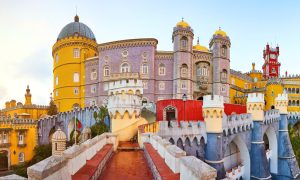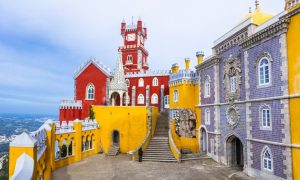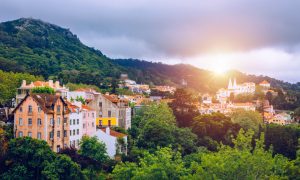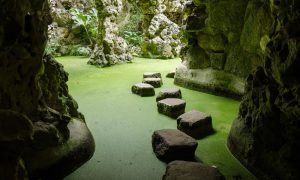Few places in the world can match the mystical allure of Sintra, a town where history, natural beauty, and artistic vision converge in breathtaking harmony. Nestled in the foothills of the Sintra Mountains, this magical town is located just 30 kilometers from Lisbon, yet it feels like an entirely different realm. Recognized as a UNESCO World Heritage Site since 1995, Sintra’s cultural landscape is celebrated for its fairy-tale castles, verdant gardens, and historic palaces, making it one of Portugal’s most beloved destinations.
A Glimpse into Sintra’s Rich History
The history of Sintra stretches back thousands of years, with evidence of ancient settlements by the Celts, Romans, and Moors. In the Middle Ages, it became a favorite retreat for Portuguese nobility and royals, who were drawn to its cooler climate and picturesque setting. However, it wasn’t until the 19th century that Sintra began to flourish as a romantic haven, largely thanks to King Ferdinand II, who transformed the landscape with his visionary creations.
This era saw the construction of Pena Palace, a quintessential symbol of European Romanticism, blending influences from Gothic, Manueline, Moorish, and Renaissance architecture. Ferdinand’s influence turned Sintra into a destination that inspired poets, writers, and artists, including Lord Byron, who famously referred to it as a “glorious Eden.”
Highlights of Sintra: What Not to Miss
1. Pena Palace
Arguably the most iconic landmark in Sintra, Pena Palace is a kaleidoscope of colors and styles, perched dramatically on a hilltop. This Romanticist masterpiece, with its whimsical turrets, grand terraces, and Moorish arches, looks as though it has stepped out of a storybook. Inside, you can explore the former royal chambers and enjoy panoramic views that stretch all the way to the Atlantic Ocean.
2. Quinta da Regaleira
Quinta da Regaleira is one of Sintra’s most mysterious and enchanting estates. Built in the early 20th century, this neo-Gothic palace is surrounded by lush gardens filled with hidden tunnels, grottoes, and spiraling towers. The estate’s most famous feature is the Initiation Well, a deep, inverted tower that descends underground in a spiral of stone steps—symbolic of a spiritual journey.
3. Moorish Castle (Castelo dos Mouros)
For a glimpse of Sintra’s ancient past, the Moorish Castle is a must-see. This 9th-century fortress was built by the Moors to defend the region and offers stunning views of the surrounding landscape. Its towering stone walls, rugged ruins, and narrow pathways provide a window into the town’s medieval history. From here, you can look across the entire Sintra valley, with Pena Palace in the distance.
4. Monserrate Palace
Less visited but equally fascinating, Monserrate Palace is a hidden gem of Sintra’s architectural landscape. This 19th-century palace, with its intricate Moorish-inspired design, Indian influences, and lush gardens, feels like a private, otherworldly retreat. The exotic gardens are home to rare species of plants from all over the world, making it an ideal spot for those who enjoy both art and nature.
5. National Palace of Sintra
The National Palace of Sintra is one of the oldest and most historically significant buildings in town. Built in the 14th century and once the royal family’s summer residence, the palace is instantly recognizable by its two massive conical chimneys. The interior boasts a stunning blend of Gothic, Manueline, and Moorish designs, including the Swan Room and the breathtaking Blazons Hall, with its collection of 72 heraldic shields.
6. Sintra-Cascais Natural Park
Sintra’s natural beauty extends far beyond its palaces. The Sintra-Cascais Natural Park is a vast protected area of rugged cliffs, dense forests, and golden beaches. Hike through the Sintra Mountains, explore hidden coves along the coastline, or visit the Cabo da Roca, the westernmost point of mainland Europe, where the land meets the wild Atlantic Ocean.
Fascinating Facts about Sintra
- Sintra was the first European site classified as a “Cultural Landscape” by UNESCO. This designation recognizes not only its historical architecture but also its harmonious integration with the natural environment.
- Lord Byron, who visited Sintra in 1809, called it “the most delightful village in Europe.” His poem “Childe Harold’s Pilgrimage” mentions Sintra as a place of rare beauty.
- Sintra has long been a favorite spot for royalty and aristocrats, with palaces like Monserrate and Pena built as summer retreats to escape the heat of Lisbon.
- The Initiation Well at Quinta da Regaleira was never used as a real well—it was designed for ceremonial purposes, with ties to Masonic rituals and mysticism.
- The Moorish Castle offers a rare blend of history and nature, and its stone walls were once used as lookouts to monitor incoming ships.
Tips for Visiting Sintra
1. Arrive Early
Sintra’s popularity means it can get quite crowded, especially in the summer months. To enjoy the major sites like Pena Palace and Quinta da Regaleira in peace, plan to arrive early in the morning before the bulk of the crowds.
2. Wear Comfortable Shoes
Sintra’s terrain is hilly, with cobblestone streets and steep paths leading to the various castles and palaces. Comfortable walking shoes are a must if you plan on exploring the town on foot.
3. Use Public Transport or Tuk-Tuks
Parking can be tricky in Sintra, and the roads are often narrow and winding. Opt for the 434 tourist bus or one of the tuk-tuks to navigate between sites. The bus connects the main attractions, while the tuk-tuks provide a fun and scenic way to travel around.
4. Pack for All Weather
Even in summer, Sintra’s microclimate can be unpredictable. The higher elevation means that it can be cooler and foggy, especially in the mornings. Bring layers and be prepared for varying conditions.
5. Take a Break in the Village Center
After exploring the palaces and parks, head to Sintra’s historic center, where you can relax at one of the charming cafés or sample local delicacies like travesseiros (flaky, almond-filled pastries) and queijadas (small, sweet cheese tarts). The streets are full of quirky shops, galleries, and artisans selling handmade crafts.
Conclusion
Sintra is more than just a day trip from Lisbon—it’s a journey into Portugal’s past, where nature and culture blend seamlessly into one magnificent landscape. With its opulent palaces, lush gardens, medieval castles, and mystical aura, Sintra invites visitors to step into a world of wonder. Whether you’re marveling at the vibrant colors of Pena Palace, wandering through the secret gardens of Quinta da Regaleira, or hiking the trails of the Sintra-Cascais Natural Park, Sintra promises an unforgettable adventure filled with beauty, history, and magic.





















